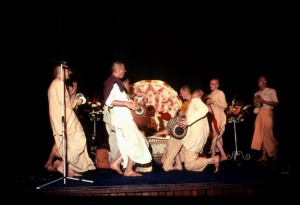CC Madhya 24.88 (1975): Difference between revisions
(Vanibot #0027: CCMirror - Mirror CC's 1996 edition to form a basis for 1975) |
(Vanibot #0020: VersionCompareLinker - added a link to the Version Compare feature) |
||
| Line 2: | Line 2: | ||
<div style="float:left">'''[[Sri Caitanya-caritamrta (1975)|Śrī Caitanya-caritāmṛta (1975)]] - [[CC Madhya (1975)|Madhya-līlā]] - [[CC Madhya 24 (1975)|Chapter 24: The Sixty-One Explanations of the Atmārāma Verse]]'''</div> | <div style="float:left">'''[[Sri Caitanya-caritamrta (1975)|Śrī Caitanya-caritāmṛta (1975)]] - [[CC Madhya (1975)|Madhya-līlā]] - [[CC Madhya 24 (1975)|Chapter 24: The Sixty-One Explanations of the Atmārāma Verse]]'''</div> | ||
<div style="float:right">[[File:Go-previous.png|link=CC Madhya 24.87 (1975)|Madhya-līlā 24.87]] '''[[CC Madhya 24.87 (1975)|Madhya-līlā 24.87]] - [[CC Madhya 24.89 (1975)|Madhya-līlā 24.89]]''' [[File:Go-next.png|link=CC Madhya 24.89 (1975)|Madhya-līlā 24.89]]</div> | <div style="float:right">[[File:Go-previous.png|link=CC Madhya 24.87 (1975)|Madhya-līlā 24.87]] '''[[CC Madhya 24.87 (1975)|Madhya-līlā 24.87]] - [[CC Madhya 24.89 (1975)|Madhya-līlā 24.89]]''' [[File:Go-next.png|link=CC Madhya 24.89 (1975)|Madhya-līlā 24.89]]</div> | ||
{{CompareVersions|CC|Madhya 24.88|CC 1975|CC 1996}} | |||
{{RandomImage}} | {{RandomImage}} | ||
==== TEXT 88 ==== | ==== TEXT 88 ==== | ||
| Line 12: | Line 11: | ||
:yac ca vrajanty animiṣām ṛṣabhānuvṛttyā | :yac ca vrajanty animiṣām ṛṣabhānuvṛttyā | ||
:dūre-yamā hy upari naḥ spṛhaṇīya-śīlāḥ | :dūre-yamā hy upari naḥ spṛhaṇīya-śīlāḥ | ||
:bhartur mithaḥ | :bhartur mithaḥ suyaśasaḥ kathanānurāga- | ||
:vaiklavya-bāṣpa-kalayā | :vaiklavya-bāṣpa-kalayā pulakīkṛtāṅgāḥ | ||
</div> | </div> | ||
| Line 20: | Line 19: | ||
<div class="synonyms"> | <div class="synonyms"> | ||
yat—which; ca—also; vrajanti—go; animiṣām—of the demigods; ṛṣabha-anuvṛttyā—by practicing the best means of spiritual life; dūre—keeping at a distance; yamāḥ—the regulative principles; hi—certainly; upari—above; naḥ—our; spṛhaṇīya-śīlāḥ—decorated with desirable qualities; bhartuḥ—of the master; mithaḥ—mutually; su-yaśasaḥ—who has all transcendental qualities; kathana-anurāga—attracted to discussions; vaiklavya—transformation; bāṣpa-kalayā—with tears in the eyes; | yat—which; ca—also; vrajanti—go; animiṣām—of the demigods; ṛṣabha-anuvṛttyā—by practicing the best means of spiritual life; dūre—keeping at a distance; yamāḥ—the regulative principles; hi—certainly; upari—above; naḥ—our; spṛhaṇīya-śīlāḥ—decorated with desirable qualities; bhartuḥ—of the master; mithaḥ—mutually; su-yaśasaḥ—who has all transcendental qualities; kathana-anurāga—attracted to discussions; vaiklavya—transformation; bāṣpa-kalayā—with tears in the eyes; pulakīkṛta—jubilation; aṅgāḥ—bodily limbs. | ||
</div> | </div> | ||
| Line 27: | Line 26: | ||
<div class="translation"> | <div class="translation"> | ||
" 'Those who discuss the activities of Lord Kṛṣṇa are on the highest platform of devotional life, and they evince the symptoms of tears in the eyes and bodily jubilation. Such persons discharge devotional service to Kṛṣṇa without practicing the rules and regulations of the mystic yoga system. They possess all spiritual qualities, and they are elevated to the Vaikuṇṭha planets, which exist above us.' | |||
</div> | </div> | ||
| Line 34: | Line 33: | ||
<div class="purport"> | <div class="purport"> | ||
This is a quotation from Śrīmad-Bhāgavatam ([[SB 3.15.25]]). In this verse Lord Brahmā is speaking to all the demigods, who feared the two asuras in | This is a quotation from Śrīmad-Bhāgavatam ([[SB 3.15.25]]). In this verse Lord Brahmā is speaking to all the demigods, who feared the two asuras in Diti's womb. Lord Brahmā described the Kumāras' visit to Vaikuṇṭha, and this was again explained by Maitreya, the friend of Vyāsadeva, when he gave instructions to Vidura. | ||
</div> | </div> | ||
Latest revision as of 15:58, 27 January 2020

A.C. Bhaktivedanta Swami Prabhupada
TEXT 88
- yac ca vrajanty animiṣām ṛṣabhānuvṛttyā
- dūre-yamā hy upari naḥ spṛhaṇīya-śīlāḥ
- bhartur mithaḥ suyaśasaḥ kathanānurāga-
- vaiklavya-bāṣpa-kalayā pulakīkṛtāṅgāḥ
SYNONYMS
yat—which; ca—also; vrajanti—go; animiṣām—of the demigods; ṛṣabha-anuvṛttyā—by practicing the best means of spiritual life; dūre—keeping at a distance; yamāḥ—the regulative principles; hi—certainly; upari—above; naḥ—our; spṛhaṇīya-śīlāḥ—decorated with desirable qualities; bhartuḥ—of the master; mithaḥ—mutually; su-yaśasaḥ—who has all transcendental qualities; kathana-anurāga—attracted to discussions; vaiklavya—transformation; bāṣpa-kalayā—with tears in the eyes; pulakīkṛta—jubilation; aṅgāḥ—bodily limbs.
TRANSLATION
" 'Those who discuss the activities of Lord Kṛṣṇa are on the highest platform of devotional life, and they evince the symptoms of tears in the eyes and bodily jubilation. Such persons discharge devotional service to Kṛṣṇa without practicing the rules and regulations of the mystic yoga system. They possess all spiritual qualities, and they are elevated to the Vaikuṇṭha planets, which exist above us.'
PURPORT
This is a quotation from Śrīmad-Bhāgavatam (SB 3.15.25). In this verse Lord Brahmā is speaking to all the demigods, who feared the two asuras in Diti's womb. Lord Brahmā described the Kumāras' visit to Vaikuṇṭha, and this was again explained by Maitreya, the friend of Vyāsadeva, when he gave instructions to Vidura.